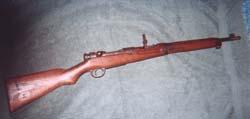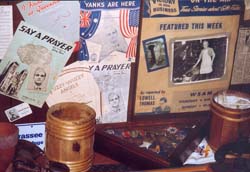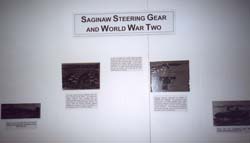
Home
- Artifacts
- Buildings & Businesses
- Churches
- Holidays & Celebrations
- Counties/Locations
- Delta College
- Early Settlers
- Ethnic Background
- Local, Michigan, U.S. and World Events
- Family Genealogy
- Farming
- Libraries & Museums
- Local Sites
- Logging
- Musicians, Artists & Famous People
- Nature, Weather & Four Seasons
- Railroads
- Schools
- Sports
The World War II Weapon
 |
As I gently slide my finger across the feather-light trigger and hold the stock tightly against my shoulder, I glance down the scope and--suddenly--it is almost as if I were there watching
the ruthless, cold-hearted soldier stalking his enemy with the metallic beaded scope steadily following the target, waiting to strike. What kind of dreadful, life-taking weapon of destruction could this be? It is a Japanese Sniper rifle used in World War II. This horrifying object currently rests in my father's gun case. It is one of the oldest pieces of family history that has been passed down from my great grandpa.
 |
World War II was an International conflict between the Axis Powers: Germany, Italy, and Japan and the Allied Powers: France, Britain, the U.S., and the Soviet Union. This means we were the helpless souls hunted within this gun's sights. This flesh ripper was the last thing the enemy wanted to see. It could take a soldier's life when he was least expecting it.
The rifle is a long, slender, and extremely heavy weapon. Just looking at the gun I can only imagine what kind of terror this thing has caused. It is similar to a 30.6, which can shoot 300 plus yards with extreme accuracy, consistency, and blazing velocity. This rifle could penetrate through almost everything except tank armor. The heavy weight is used to reduce coil and create a more powerful effect. This made it one of the primary lethal weapons on the battle field.
The main material used for the rifle was a rock-solid wood, appearing to be stained with a deep walnut finish. Ash is the only comparable wood, with its fine course texture which is smooth to the touch. The wood now looks similar to a piece of wood from an abandoned house, due to the extreme brutality of the acidic rain beading on it in the battle field. The stock of the rifle looks like it was stained with a dark cherry or walnut stain, which was good camouflage. The trigger guard, trigger, scope, and the barrel are all corroded with a ridged-type texture.
The original shiny metal layer is now covered with green lime and a brown, flaky, rust-like substance. Underneath the barrel is a long, thin tube with a hole at the end, where a bayonet used to screw in. The bayonet was the secondary weapon, used as a long sword or knife to slaughter people. Since the bayonet is no longer intact with the gun, the gun seems dead. The bayonet came out past the barrel of the rifle, and was made out of a shiny, stainless metal with a rigid end that could easily tear through human flesh.
The WW II scope was not the type of scope that is on most hunting rifles or any rifle today. This scope was a one of a kind. There are two slender tips, which allow the shooter to look down the barrel to match even the thinnest cross-hair between them. The bullets for this rifle were long, sleek, and moderately thick, with a lead tip and a brass-colored casing to hold a wide variety of grains.
There is little known about how my grandfather had got this rifle. He could have picked it up off the ground, because he fought in WW II. Although the rifle has taken a beating and has numerous bruises and nicks on it, it will always be a part of the family. It serves as a remembrance of one of the most brutal, life-taking wars in the history of America.
 |
For more information regarding World War II weaponry and Saginaw's Steering Gear's role in manufacturing WWII weapons, visit the Castle Museum of Saginaw County History.
| The written and visual works in Mid-Michigan Remembers-Stories about Us were chosen on the basis of their quality, diversity, community interest and appeal. Views expressed do not necessarily reflect those of the College. This space is provided as a service by Delta College. |